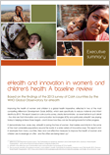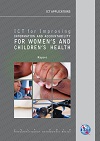eHealth and innovation in women's and children's health: A baseline review

Information and communication technologies (ICTs) play an increasingly critical role in providing health services, including for women’s and children’s health. This joint publication by the World Health Organization (WHO) and the International Telecommunication Union (ITU) reports the results of the first survey to study the impact of eHealth on women’s and children’s health in developing countries. It highlights many encouraging findings including the development of national eHealth policies, the monitoring of key indicators, and the implementation of electronic information systems. Recommendations for the way forward are proposed. Never before has there been such a high response rate for a Global Observatory for eHealth (GOe) survey. This is a clear reflection that countries are now recognizing the importance of innovation through ICTs to advancing women’s and children’s health.rable populations around the world, in a wide variety of innovative ways.
More...
ICT for improving information and accountability for Women’s and Children’s Health (2013)
Information and communication technology (ICT) and eHealth applications play an essential role in meeting the ten recommendations set by the
Commission on Information and Accountability for Women’s and Children’s Health (CoIA). Together, they aim at creating a system to track whether donations for women's and children's health are made on time, if resources are spent wisely and transparently, and whether the desired results are achieved. This report reviews each of the ten CoIA recommendations, highlighting the contributions ICT applications can provide in their implementation and in fast tracking the fulfilment of the MDGs 4 and 5.
More...
E-health Standards and Interoperability (2012)

The report explains how rapid advancements in the development of e-health standards must accompany three trends in electronic healthcare in the coming decade: 1. Advancements in healthcare delivery via mobile and wireless e-health technologies; 2. Personalized medicine, including personal health records, medical diagnostic devices, and biometric records; and 3. Interactive healthcare via social media and Web 2.0 applications. The report also provides an introduction to some of the institutions working to develop standards in the capacious area of e-health. The report concludes by suggesting five standards prerequisites necessary for achieving the promise of e-health: emphasizing greater interoperability, increasing coordination over global e-health standardization, ensuring privacy and security, reducing the standardization gap in the developing world, and leveraging existing technologies like mobile devices and social media applications.
More...
National eHealth Strategy Toolkit (2012)

The National eHealth Strategy Toolkit is a resource for developing or revitalizing a country’s eHealth strategy, from countries just setting out to those that have already invested significantly in eHealth. This includes countries that are seeking to build on promising results from pilot initiatives, establish foundations for scaling up eHealth projects, or update strategies to reflect changing circumstances. The Toolkit can be used by government health sector leaders in ministries, departments and agencies who will manage the development of an eHealth strategy. Its application requires a team experienced in strategic planning, analysis, communication and stakeholder engagement.
More...
Scaling e-Health Services in step with ICT Transformation (2011)

Global investments for modernization of infrastructure is in a race with rapidly growing health-related economic loss of productive life years associated degradation in quality of life. Hence it is extremely important to understand which e-Health services can be deployed immediately with available infrastructure and which additional services can be added, as the infrastructure is transformed according to the needs and constraints of the target demographics. Adopting this point of view, this paper is presents a methodology of study the ICT requirements of a complex health care system in terms of its activities, transactions and nature of information exchanges, and map their computing and communication needs at the point of Care to existing technology standards.
Case-studies and data from several pioneering e-Health initiatives in India have been sought for applying the methodology and gain useful insight. However, the emphasis is this paper is more on the method than the data samples, so that a typical data-driven governance system may use the method and fit relevant data from their own demography to diligently prioritize investments with more accurate expectation of outcomes by scaling e-Health services in step with ICT transformation.
More...
Case Study: Landscape of tele-health infrastructure at points-of-service in India (2011)
The report identifies the activities, transactions and type of information exchange that take place within the health care activities. Various usage models and infrastructure employed at the point-of-care were surveyed from ongoing e-Health projects to identify the adoption pattern of connectivity and end-user platform technologies for various e-health services.
More...
Mobile e-Health Solutions for Developing Countries (2010)

The report highlights the role of mobile telecommunication technology in health care by offering at a distance the medical consultation and administration of patient treatment. The goal of the report is to offer some practical information on some of the ongoing Mobile Health solutions. The report provides some background information related to: what is Mobile Health, how to use Clinical Decision Support Software and Traffic Control System for Medical Information Network, Models of Wireless Access and Connectivity, etc.; and presents some practical examples from different countries.
More...
Implementing e-Health in Developing Countries: Guidance and Principles

Implementing e-Health in Developing Countries.
More...